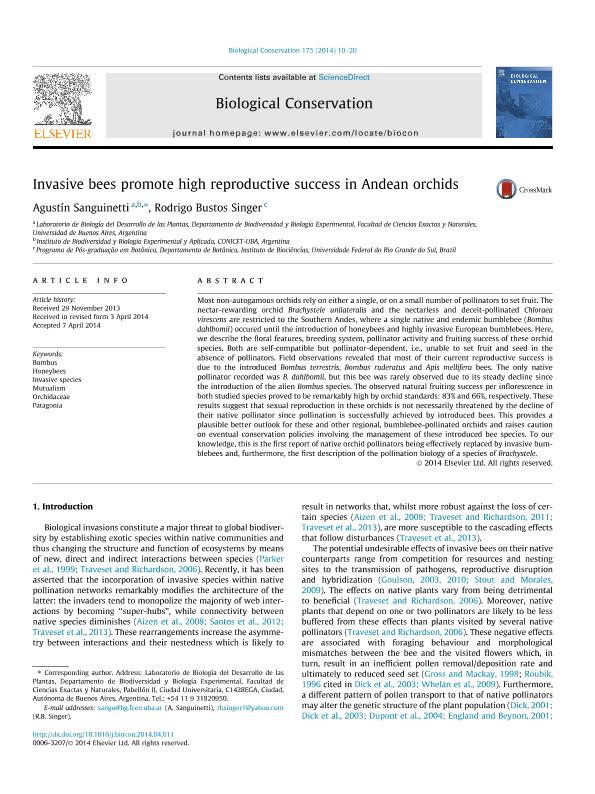Mostrar el registro sencillo del ítem
dc.contributor.author
Sanguinetti, Agustin

dc.contributor.author
Singer, Rodrigo Bustos

dc.date.available
2017-07-04T18:56:52Z
dc.date.issued
2014-07
dc.identifier.citation
Sanguinetti, Agustin; Singer, Rodrigo Bustos; Invasive bees promote high reproductive success in Andean orchids; Elsevier; Biological Conservation; 175; 7-2014; 10-20
dc.identifier.issn
0006-3207
dc.identifier.uri
http://hdl.handle.net/11336/19496
dc.description.abstract
Most non-autogamous orchids rely on either a single, or on a small number of pollinators to set fruit. The nectar-rewarding orchid Brachystele unilateralis and the nectarless and deceit-pollinated Chloraea virescens are restricted to the Southern Andes, where a single native and endemic bumblebee (Bombus dahlbomii) occured until the introduction of honeybees and highly invasive European bumblebees. Here, we describe the floral features, breeding system, pollinator activity and fruiting success of these orchid species. Both are self-compatible but pollinator-dependent, i.e., unable to set fruit and seed in the absence of pollinators. Field observations revealed that most of their current reproductive success is due to the introduced Bombus terrestris, Bombus ruderatus and Apis mellifera bees. The only native pollinator recorded was B. dahlbomii, but this bee was rarely observed due to its steady decline since the introduction of the alien Bombus species. The observed natural fruiting success per inflorescence in both studied species proved to be remarkably high by orchid standards: 83% and 66%, respectively. These results suggest that sexual reproduction in these orchids is not necessarily threatened by the decline of their native pollinator since pollination is successfully achieved by introduced bees. This provides a plausible better outlook for these and other regional, bumblebee-pollinated orchids and raises caution on eventual conservation policies involving the management of these introduced bee species. To our knowledge, this is the first report of native orchid pollinators being effectively replaced by invasive bumblebees and, furthermore, the first description of the pollination biology of a species of Brachystele.
dc.format
application/pdf
dc.language.iso
eng
dc.publisher
Elsevier

dc.rights
info:eu-repo/semantics/openAccess
dc.rights.uri
https://creativecommons.org/licenses/by-nc-nd/2.5/ar/
dc.subject
Bombus
dc.subject
Honeybees
dc.subject
Invasive Species
dc.subject
Mutualism
dc.subject
Orchidaceae
dc.subject
Patagonia
dc.subject.classification
Ciencias de las Plantas, Botánica

dc.subject.classification
Ciencias Biológicas

dc.subject.classification
CIENCIAS NATURALES Y EXACTAS

dc.subject.classification
Conservación de la Biodiversidad

dc.subject.classification
Ciencias Biológicas

dc.subject.classification
CIENCIAS NATURALES Y EXACTAS

dc.subject.classification
Ecología

dc.subject.classification
Ciencias Biológicas

dc.subject.classification
CIENCIAS NATURALES Y EXACTAS

dc.title
Invasive bees promote high reproductive success in Andean orchids
dc.type
info:eu-repo/semantics/article
dc.type
info:ar-repo/semantics/artículo
dc.type
info:eu-repo/semantics/publishedVersion
dc.date.updated
2017-07-04T15:33:48Z
dc.journal.volume
175
dc.journal.pagination
10-20
dc.journal.pais
Países Bajos

dc.journal.ciudad
Amsterdam
dc.description.fil
Fil: Sanguinetti, Agustin. Consejo Nacional de Investigaciones Científicas y Técnicas. Oficina de Coordinación Administrativa Ciudad Universitaria. Instituto de Biodiversidad y Biología Experimental y Aplicada. Universidad de Buenos Aires. Facultad de Ciencias Exactas y Naturales. Instituto de Biodiversidad y Biología Experimental y Aplicada; Argentina
dc.description.fil
Fil: Singer, Rodrigo Bustos. Universidade Federal do Rio Grande do Sul; Brasil
dc.journal.title
Biological Conservation

dc.relation.alternativeid
info:eu-repo/semantics/altIdentifier/doi/http://dx.doi.org/10.1016/j.biocon.2014.04.011
dc.relation.alternativeid
info:eu-repo/semantics/altIdentifier/url/http://www.sciencedirect.com/science/article/pii/S000632071400158X
Archivos asociados
